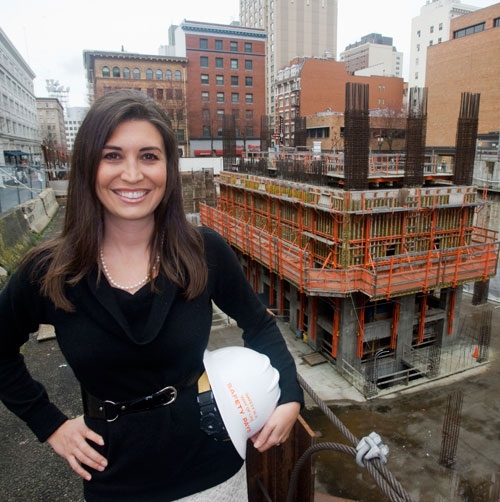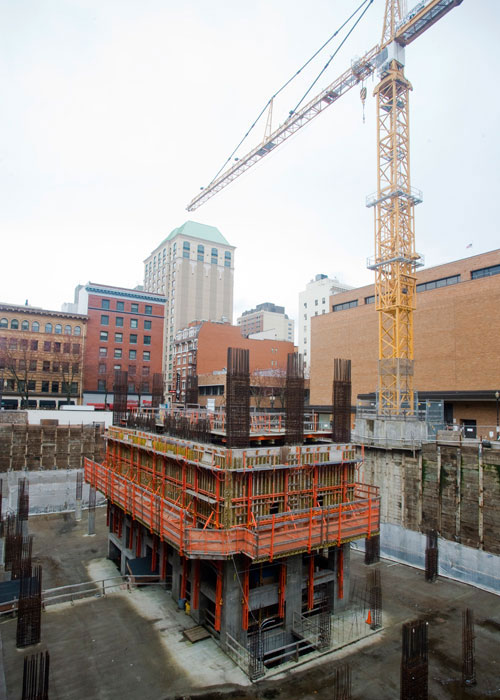 Tom Moyer’s granddaughter struggles to revive Park Avenue West, a lingering wound in the heart of Portland’s downtown. It’s a fight against the economy, the market and maybe even her family.
Tom Moyer’s granddaughter struggles to revive Park Avenue West, a lingering wound in the heart of Portland’s downtown. It’s a fight against the economy, the market and maybe even her family.
By Oakley Brooks
 |
Vanessa Sturgeon, president of TMT Development near the stalled construction of the Park Avenue West office tower at Park and Yamhill in downtown Portland. // Photo by Anthony Pidgeon |
TMT Development is caught in a trap. One of the lions of downtown Portland real estate development, it’s looking to erase a black eye dished out by the financial crash and to cover that construction pit at Park and Yamhill with the completed high-end office tower, Park Avenue West. But after a potential deal-clinching lease with the Portland Development Commission fell through last summer, future tenants and prospective lenders are now skittish about signing onto the project. Big tenants all over town are skeptical it will actually happen after lying dormant for three years.
In order to impress them, “The goal is to get the building out of the ground and have something to talk about before pursuing big tenants,” says Vanessa Sturgeon, TMT Development’s 33-year-old president. But banks, life insurance companies, pension funds or trusts who might offer the means to finish the project want to see roughly half of the building’s 22 stories leased before they’ll hand over the money.
“It’s all swirling around at the same time,” says Sturgeon, with a hint of hope that something may come out of discussions around town. In mid-April, the company submitted a proposal to the City of Portland, along with several other developers, in an attempt to win the Bureau of Environmental Services’ 75,000-square-foot lease.
With no concrete progress, however, rumors about Park Avenue West’s revival — alive since the fourth quarter of last year — continue to die in that motionless downtown pit and leave it as a lingering wound from the Great Recession.
That Sturgeon is opening up at all about negotiations is a sign of anxiety at TMT. Under Sturgeon’s bullish grandfather, Tom Moyer, the company built and continues to manage 9 million square feet of office space from Salem to Seattle, including the 1000 Broadway building and the magestic Fox Tower building at the heart of Portland. Moyer has been an important corporate citizen, building an auditorium at Central Catholic High School, offering scholarships through a trust named after his late wife, Marilyn, and donating at least $7 million for land and construction costs for Director Park, opposite the Fox Tower. But the company has rigorously maintained a low media profile, preferring to stick to an adage borrowed from reclusive venture capitalist Henry Hillman: “The spouting whale gets the harpoon.”
“They are a closely held family company and they just don’t burn a lot of calories on outreach,” says Bart Eberwein, vice president at Hoffman Construction, which is the general contractor on Park Avenue West and built the Fox Tower.
But Sturgeon admits the worth of the company’s real estate has, not surprisingly, dropped precipitously in value in recent years. And there may be more stress in the company, out of view.
Moyer is now 92, and though Sturgeon says, “He’s holding up incredibly well,” she would not allow him to be interviewed. Sources in the commercial real estate community say Moyer’s memory trouble, often chalked up to a lovable forgetfulness, is now a sign of advancing age. There’s a chance that his company would pass into estate before the Park Avenue West project is finished, and family members who stand to inherit the company and Moyer’s personal wealth may not want more of his money put into Park Avenue West.
Sturgeon says that picture of behind-the-scenes activity is “inaccurate.” But when asked if the family was supportive of the project she won’t answer: “I’m not going to comment on the family’s position,” she says.
 It’s in times like these that the company — through Moyer or Sturgeon — has been known to buck its own policy and seek the media spotlight.
It’s in times like these that the company — through Moyer or Sturgeon — has been known to buck its own policy and seek the media spotlight.
In 1997, Moyer broke ground without any financing on the Fox Tower project; two years in, with $90 million of his own money already committed, he had no more than a fifth of the future space rented. Development competitors expected him to fold, but Moyer had a card left to play: his life story. Inviting The Oregonian’s R. Gregory Nokes into his Vancouver, Wash., home, Moyer laid out a drama worthy of Alger, about his rise from hard-scrabble Depression baby beginnings in Sellwood, his abandonment of school to pursue an amateur boxing career that put him in the ring with legendary Sugar Ray Robinson, through the growth of his theater conglomerate that led to a falling out with his siblings but eventually earned him $192 million upon sale in 1989, and finally, tossing out some anecdotes of the stinginess and forgetfulness that friends and family said defined him.
Nokes was even offered a view from the top of the skeletal concrete elevator shaft Hoffman had put in first at the Fox Tower, and here was the trade-off: Moyer, whom Sturgeon describes as “excruciatingly private,” was willing to expose himself in exchange for some free publicity. “He felt he had to,” says Sturgeon.
The outreach effort, combined with an aggressive sales pitch from Moyer’s team of high-powered brokers, worked. In late 1999, timber magnate Louisiana Pacific committed to leaving the choicest office address in Portland — the top two floors at U.S. Bancorp Tower — for the Fox Tower. That led to a construction loan from Bank of America, and by the time the building was finished it was over 90% leased. Moyer moved into his own apartment on the upper floors of Fox Tower, the new “it” spot in town.
A mini-charm offensive from Sturgeon last spring, however, couldn’t rescue TMT’s $50 million investment already sunk into Park Avenue West. The Portland Development Commission was weighing a move from its Old Town offices into Park Avenue West that — with commitments from Stoel Rives to half the office space and Nike to a retail store — would have secured a construction loan from Pacific Life to finish the tower. Sturgeon and Co. hired a public affairs consultant to navigate the PDC’s public bid process and Sturgeon sat for an interview with the Portland Business Journal.
But that restart fell through when PDC officials couldn’t justify paying an estimated $10-a-square-foot premium to move commission offices to Park Avenue West. It was a prime example of the persistence of low rents around the city that have been a drag on new office projects.
That brings us to TMT’s latest predicament: It’s without a loan and without Stoel Rives, which renewed its lease at the Standard Insurance Tower last August. The company needs to show its face again.
Sturgeon operates from a modest, south-facing office on the Fox Tower’s 20th floor. She can be approachable and charming, flashing sparkling eyes as she talks of her imminent escape from spring dreariness to Mexico with her husband and two small boys. But as the conversation shifts to business, it shortens, each of her words measured cautiously. Despite the fact that she’s held the title of president for 10 years now, since she joined TMT as a young Willamette University graduate student at Moyer’s request, she admits to being “nervous” about how the ongoing Park Avenue West saga is playing out in public. “I’m worried I’m going to get reamed over it,” in future press, she says.
{pullquote}I’m worried I’m going to get reamed over it. -Vanessa Sturgeon{/pullquote}
Sturgeon offers brief glimpses of how difficult the last three years have been. She signed the stop work orders at Park Avenue West in April 2009, a week after her second son, Cole, was born, and a few days after closing on a new house in Lake Oswego.
“It was all a blur,” she says.
Shutting down the project “was incredibly hard. The hardest part was there were no other construction jobs for the workers to jump to.”
“[The downturn] has been hard for people in the office,” she says. “They call counterparts at other firms and they’re just gone, voice mail disconnected. These are people who’ve worked for the same place for 10 or 20 years. So it’s tough for morale.”
But asked if the sight of that dormant hole kitty-corner from the Fox Tower gets under her skin, she grows terse. “It’s just part of the landscape now,” she says.
There is undoubtedly a hard-nosed edge to Sturgeon. She reportedly announced intentions to sue her father, Elie Kassab, for ownership of a theater property in Vancouver, Wash., after dinner at his house with her brother and sister in 2005. The children thought they’d been wronged in a divorce settlement between their mother, Kimberly Moyer, and Kassab, which granted him the company. (Sturgeon and her siblings lost in court.)
By the accounts of business associates, Sturgeon is now the developer in charge at TMT. But she says Moyer still remains a close adviser, descending from his condominium to the office every day, and checking in by phone when at his second home in Rancho Mirage, Calif. “We talk about everything,” Sturgeon says.
If Sturgeon and Moyer can convince their family, tenants and lenders to support Park Avenue West, there are some broader trends working in the company’s favor.
Market researchers and local economists note that Portland, like cities all over the country, is substantially under building commercial space as a result of the credit crunch, following a few years of below-average commercial construction during the last period of growth. All of that will lead to heavy demand for new space in the coming years and a “mini-boom” in construction, Portland economist Bill Conerly wrote recently in his blog.
By the end of this year, the office vacancy rate in downtown Portland is projected to be 9.3%, the lowest of any major U.S. business district besides Manhattan’s midtown south, according to commercial real estate brokers Cushman & Wakefield. Some market reports for the first quarter of 2011 listed the luxury Class A vacancy rate in Portland as low as 6.3%. Just a handful of multi-floor spaces are left in existing high-end towers in Portland’s core. When the next big client, such as Iberdrola Renewables or a city department, decides to move, “They basically require a new building,” says Tom Usher, Cushman-Wakefield’s senior director in Portland.
The pent-up demand for Class A space meant gold for Shorenstein Properties, which recently sold its building at First and Main for $129 million or $350 per square foot.
And that now means lenders are opening up to new commercial construction deals in Portland.
“I know a number of lenders are open to a deal. They are just looking for the right deal,” says John Petersen, a mortgage banker who heads Melvin Mark Capital. But Petersen also says that potential creditors and tenants have to overcome lingering doubts about the overall state of the economy before a new building becomes a reality. “It takes a turn of psychology,” he says.
In the meantime, Vanessa Sturgeon and TMT wait, and she tries to look at the moment through Tom Moyer’s 92-year-old eyes.
“He’s seen the economy go through cycles like this many times, including the Depression, so two or three years don’t make a big difference to him.” she says. “This is just one more cycle.”


